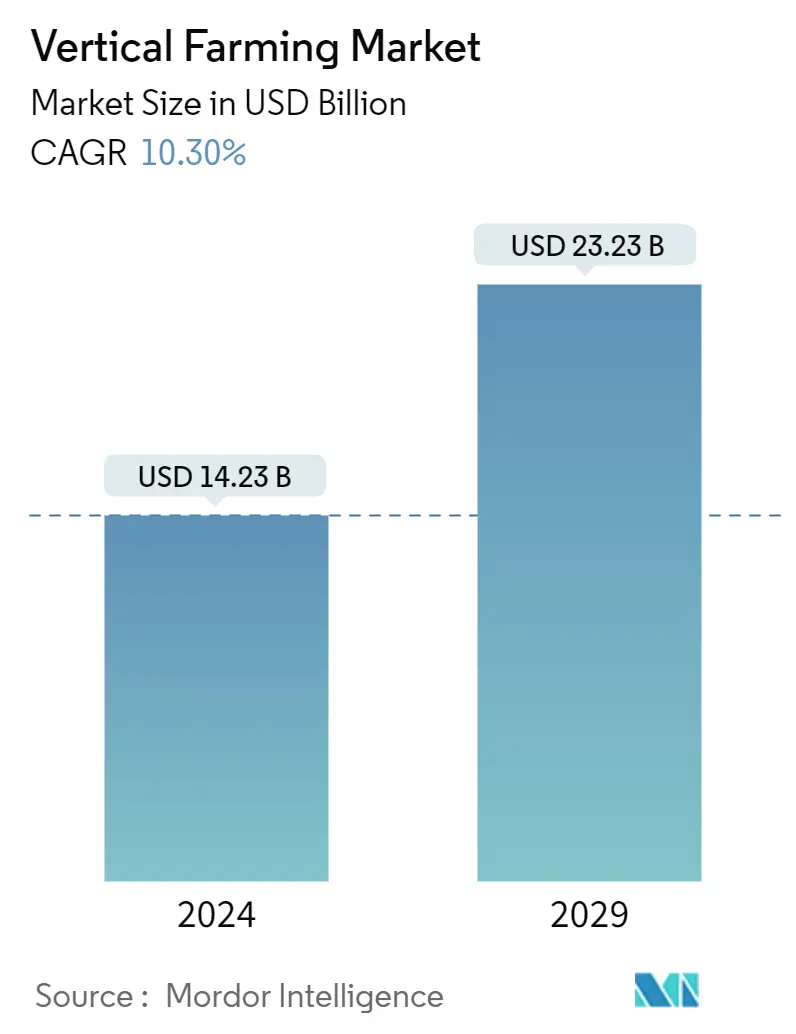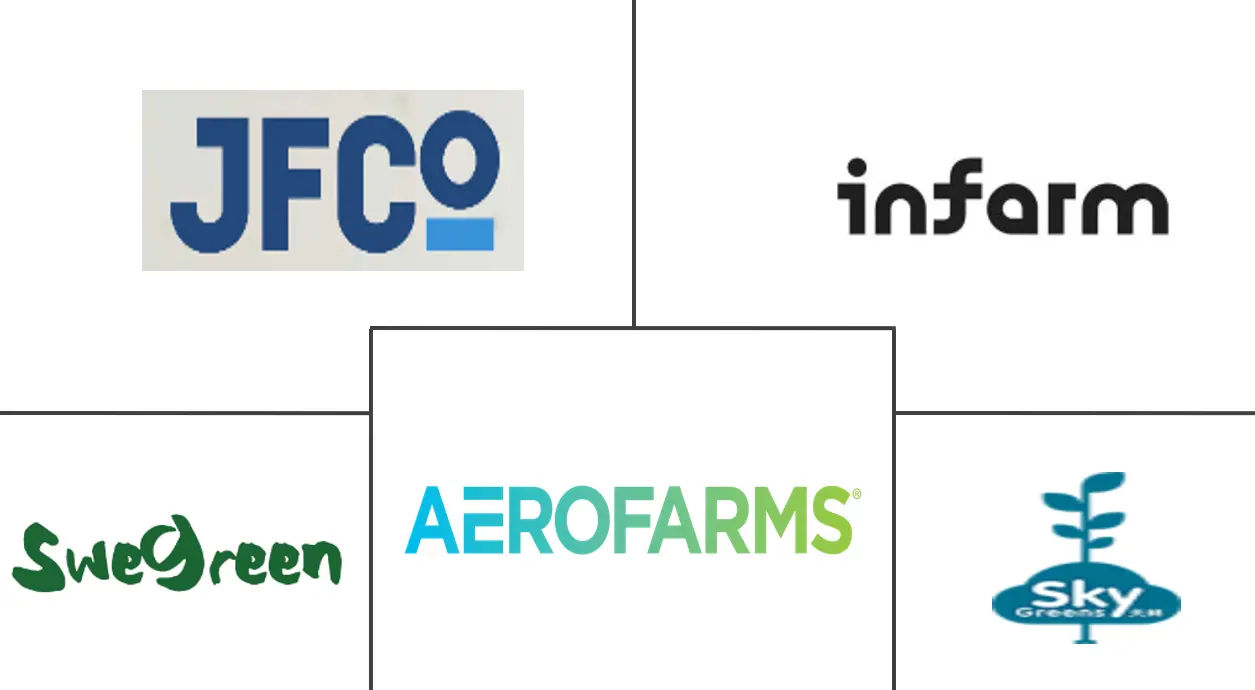| Study Period | 2018 - 2029 |
| Market Size (2024) | USD 14.23 Billion |
| Market Size (2029) | USD 23.23 Billion |
| CAGR (2024 - 2029) | 10.30 % |
| Fastest Growing Market | Asia-Pacific |
| Largest Market | North America |
| Market Concentration | Low |
Major Players*Disclaimer: Major Players sorted in no particular order |
Vertical Farming Market Analysis
The Vertical Farming Market size is estimated at USD 14.23 billion in 2024, and is expected to reach USD 23.23 billion by 2029, growing at a CAGR of 10.30% during the forecast period (2024-2029).
- The increased demand for organic products among consumers, fueled by the improved standard of living and higher disposable income paved the way for the development of vertical farming, wherein organic farming is practiced widely. People are growing the necessary crops in their own houses on a small scale to have food free from pests. An increase in health consciousness and consumption of residue-free food has paved the way for the usage of advanced techniques, like hydroponics, aeroponics, etc.
- Microgreens are among the crops cultivated by vertical farming methods and are a rich source of polyphenols, a class of antioxidants that helps to lower the risk of diseases, such as heart disease, Alzheimer's disease, diabetes, and certain cancers.
- With the growing innovation in agricultural technology, the industry is growing rapidly, attracting individual as well as commercial attention. Many commercial growers are adopting high capital expenditure technologies, such as advanced hydroponic systems and electronic traceability systems. Additionally, growers are heavily investing in LEDs and other innovative lighting products to reduce their exposure to associated risks by carefully monitoring and investing in new technologies.
- The need for food supply against the explosive population is expected to increase by 2050, which has catalyzed the growth of the vertical farming market. Funds are being invested in the market to bring developments and technological advancements to this specific sector. The control over the growth of plants and the minimum resource requirements in terms of space, water, etc. is making this technique more popular as the global food crunch is around the corner in many parts of the world. The increased need to meet the demand of the growing population and limited and scarce agricultural land and water are anticipated to drive the global market for vertical farming during the forecast period.
Vertical Farming Industry Segmentation
Vertical farming is a farming method through which crops are grown in vertically stacked layers. It is done in a controlled environment using techniques, such as aquaponics, hydroponics, and aeroponics that do not make use of soil.
The Vertical Farming Market is segmented by Growth Mechanism (Aeroponics, Hydroponics, and Aquaponics), Structure (Building-based Vertical Farms and Shipping Container-based Vertical Farms), Components (Lighting, Climate Control, Sensors, and Other Hydroponic Components), Crop (Tomato, Berries, Lettuce and Leafy Vegetables, Pepper, Cucumber, Microgreens, and Other Crop Types), and Geography (North America, Europe, Asia-Pacific, South America, and Africa). The report offers market estimation and forecasts in value (USD million) for the above-mentioned segments.
| Aeroponics |
| Hydroponics |
| Aquaponics |
| Building-based Vertical Farms |
| Shipping Container-based Vertical Farms |
| Lighting |
| Climate Control |
| Sensors |
| Other Hydroponic Components |
| Tomato |
| Berries |
| Lettuce and Leafy Vegetables |
| Pepper |
| Cucumber |
| Microgreens |
| Other Crop Types |
| North America | United States |
| Canada | |
| Mexico | |
| Rest of North America | |
| Europe | United Kingdom |
| France | |
| Sweden | |
| Rest of Europe | |
| Asia-Pacific | Singapore |
| China | |
| Japan | |
| Taiwan | |
| Rest of Asia-Pacific | |
| South America | Brazil |
| Rest of South America | |
| Africa | South Africa |
| Rest of Africa |
Vertical Farming Market Size Summary
The vertical farming industry is experiencing significant growth, driven by the increasing demand for organic products and the need for sustainable agricultural practices. As consumers become more health-conscious and seek residue-free food, advanced farming techniques such as hydroponics and aeroponics are gaining popularity. This trend is further supported by the rising urbanization and the decline in arable land due to factors like climate change and population growth. Vertical farming offers a solution by optimizing land use and minimizing resource requirements, making it an attractive option for both individual and commercial growers. The industry is witnessing substantial investments in technology and innovation, with companies adopting high-capital expenditure systems to enhance productivity and meet the growing food demand.
The market landscape is highly fragmented, with numerous players competing for market share. Major companies like Aerofarms, Infarm, and Jones Food Company are leading the charge, while new entrants are exploring opportunities in regions such as Asia-Pacific. The United States, in particular, is a dominant player in the North American market, with increasing investments in vertical farming infrastructure to address food security concerns. The expansion of vertical farming facilities, such as the large-scale operations planned by Upward Farms in Pennsylvania, highlights the industry's potential for growth. As the demand for fresh, locally grown produce continues to rise, vertical farming is poised to play a crucial role in the future of food production, offering a sustainable alternative to traditional farming methods.
Vertical Farming Market Size - Table of Contents
1. MARKET DYNAMICS
- 1.1 Market Overview
-
1.2 Market Drivers
- 1.2.1 Increased Focus on Organic Farming
- 1.2.2 Rising Urbanization and Demand for Locally Grown Fresh Produce
- 1.2.3 Technological Advancement in Controlled Environment Agriculture
-
1.3 Market Restraints
- 1.3.1 High Initial Investment and Operational Costs
- 1.3.2 Limited Crop Variety Suitable for Vertical Farming Systems
-
1.4 Industry Attractiveness - Porter's Five Forces Analysis
- 1.4.1 Bargaining Power of Suppliers
- 1.4.2 Bargaining Power of Buyers
- 1.4.3 Threat of New Entrants
- 1.4.4 Threat of Substitute Products
- 1.4.5 Intensity of Competitive Rivalry
2. MARKET SEGMENTATION
-
2.1 Growth Mechanism
- 2.1.1 Aeroponics
- 2.1.2 Hydroponics
- 2.1.3 Aquaponics
-
2.2 Structure
- 2.2.1 Building-based Vertical Farms
- 2.2.2 Shipping Container-based Vertical Farms
-
2.3 Components
- 2.3.1 Lighting
- 2.3.2 Climate Control
- 2.3.3 Sensors
- 2.3.4 Other Hydroponic Components
-
2.4 Crop
- 2.4.1 Tomato
- 2.4.2 Berries
- 2.4.3 Lettuce and Leafy Vegetables
- 2.4.4 Pepper
- 2.4.5 Cucumber
- 2.4.6 Microgreens
- 2.4.7 Other Crop Types
-
2.5 Geography
- 2.5.1 North America
- 2.5.1.1 United States
- 2.5.1.2 Canada
- 2.5.1.3 Mexico
- 2.5.1.4 Rest of North America
- 2.5.2 Europe
- 2.5.2.1 United Kingdom
- 2.5.2.2 France
- 2.5.2.3 Sweden
- 2.5.2.4 Rest of Europe
- 2.5.3 Asia-Pacific
- 2.5.3.1 Singapore
- 2.5.3.2 China
- 2.5.3.3 Japan
- 2.5.3.4 Taiwan
- 2.5.3.5 Rest of Asia-Pacific
- 2.5.4 South America
- 2.5.4.1 Brazil
- 2.5.4.2 Rest of South America
- 2.5.5 Africa
- 2.5.5.1 South Africa
- 2.5.5.2 Rest of Africa
Vertical Farming Market Research Faqs
How big is the Vertical Farming Market?
The Vertical Farming Market size is expected to reach USD 15.52 billion in 2025 and grow at a CAGR of 10.30% to reach USD 25.34 billion by 2030.
What is the current Vertical Farming Market size?
In 2025, the Vertical Farming Market size is expected to reach USD 15.52 billion.




